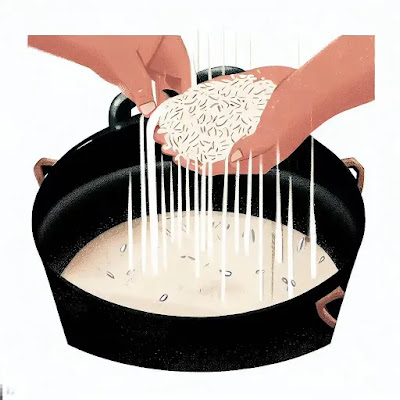Rice is a versatile and delicious grain that has been a dietary staple in many cultures for centuries. It is used in a wide range of dishes, from sushi to paella, and can be cooked in various ways, including boiling, steaming, or even microwaving. Rice is also an important source of carbohydrates and nutrients, such as vitamin B and iron.
Despite its popularity and importance, many people don't realize the importance of properly preparing rice, and rinsing is often one of the most overlooked steps. Rinsing rice is a simple process that involves washing the grains under cold running water before cooking them. It may seem like an unnecessary step, but it can have a big impact on the final texture and flavor of the rice.
In this article, we'll explore why rinsing rice is so important, how to do it properly, and common misconceptions surrounding rice rinsing. Whether you're a seasoned chef or a novice cook, understanding the importance of rinsing rice can help you achieve perfect results every time. So, let's dive in and explore the world of rice preparation!
Why Rinse Rice?
Rinsing rice is an important step in the rice preparation process for a number of reasons. Here are some of the most important ones:
- Removing debris and dirt: The debris and dirt that can be found on rice grains can come from various sources such as the milling process, handling during transportation, and storage conditions. By rinsing the rice, you're not only removing these impurities but also reducing the chances of consuming any unwanted substances. This is particularly important if you're using rice in dishes where the flavor of the rice is prominent, such as sushi, where the rice is seasoned with vinegar and sugar.
- Removing excess starch: The natural starches in rice are what make the grains sticky and help them hold their shape, but too much starch can result in clumpy or gummy rice. Rinsing the rice helps remove some of the excess starch, which results in grains that are less likely to stick together. In addition to creating fluffier, more separated grains, rinsing the rice can also help the rice cook more evenly, which can be important for dishes where the texture of the rice is important, such as paella or risotto.
- Improving texture and flavor: Rinsing rice can help improve the texture and flavor of the cooked rice. By removing impurities and excess starch, the grains can cook more evenly and absorb water more effectively, resulting in a better texture. Additionally, rinsing can remove any off-flavors that may be present in the rice, such as the slightly musty or stale taste that can come from rice that has been stored for a long time. This can be particularly noticeable in white rice, which can have a subtle but distinct flavor that can be improved by rinsing.
- Preventing clumping: Rinsing rice can help prevent the grains from clumping together during cooking, which can make the rice less appetizing and harder to eat. This is particularly important for dishes where the individual grains of rice are meant to be distinct, such as biryani or fried rice. Rinsing the rice can help ensure that the grains cook evenly and don't stick together, resulting in a more appealing and flavorful dish.
- Reducing arsenic levels: Arsenic is a naturally occurring element that can be found in the soil and water in some parts of the world. Rice can absorb arsenic from the soil and water during growth, and some types of rice can contain higher levels of arsenic than others. Rinsing rice before cooking can help reduce the level of arsenic in the grains by up to 30%, according to some studies. Additionally, cooking rice with a higher water-to-rice ratio or using a rice cooker with an automatic rinse cycle can further reduce arsenic levels.
- Making rice more digestible: Rinsing rice before cooking can make it more easily digestible. Rice contains phytic acid, which can make it difficult for your body to absorb nutrients. Soaking and rinsing rice can help reduce the amount of phytic acid, making it easier for your body to digest and absorb the nutrients in the rice. This is particularly important for people who have digestive issues or who are looking to optimize their nutrient intake.
- Reducing cooking time: Rinsing rice can help reduce the cooking time, which can be beneficial if you're short on time or if you're cooking for a large group. By removing excess starch and debris, the grains can cook more quickly and more evenly, resulting in rice that is ready to serve in less time. This can also be helpful for dishes that require pre-cooking of the rice, such as sushi or stuffed grape leaves.
- Preventing boil-over: When you cook rice, the water can sometimes boil over the top of the pot, creating a mess and potentially wasting some of the rice. Rinsing the rice before cooking can help prevent boil-over by removing excess starch that can cause the water to foam and bubble up. Additionally, rinsing can help prevent the rice from clumping together, which can also contribute to boil-over.
- Reducing sodium levels: If you're concerned about sodium intake, rinsing rice can help reduce the sodium levels in the cooked rice. Some rice products, such as instant rice or flavored rice mixes, can be high in sodium, so rinsing the rice can help remove some of the sodium content. This can be especially helpful if you're on a low-sodium diet or if you're trying to manage your blood pressure.
There are many reasons to rinse rice before cooking, and the benefits go beyond just improving the texture and flavor of the rice. By following proper rice preparation techniques, you can make sure that your rice is safe, healthy, and delicious, while also optimizing the nutritional benefits and minimizing any unwanted substances.
How to rinse rice
Rinsing rice is a simple process, but it is important to do it properly to ensure that your rice is clean and of the highest quality. Here are the steps to follow:
- Measure the rice: Begin by measuring out the desired amount of rice. You can use a measuring cup or a kitchen scale to get an accurate measurement.
- Rinse the rice: Place the rice in a fine-mesh strainer and rinse it under cold running water. Use your hands to gently stir the rice around as you rinse it to ensure that all of the grains are cleaned. Continue rinsing until the water runs clear.
- Soak the rice (optional): Some people prefer to soak their rice before cooking it, as it can help improve the texture and flavor. If you want to soak your rice, place it in a bowl and cover it with cold water. Let it soak for at least 30 minutes, or up to 2 hours for brown rice. Drain the water and rinse the rice again before cooking.
- Wash the rice (optional): Washing the rice can help remove excess starch and debris, but it is not necessary for most types of rice. If you want to wash your rice, place it in a bowl and cover it with cold water. Use your hands to gently rub the grains together, then drain the water. Repeat this process 2-3 times until the water runs clear.
- Drain the rice: After rinsing and soaking (if desired), drain the rice in the strainer and shake off any excess water. Let the rice sit in the strainer for a few minutes to allow any remaining water to drip off.
By following these steps, you can ensure that your rice is clean, free from debris, and ready to cook. It is important to note that some types of rice, such as basmati or jasmine rice, may require slightly different preparation methods, so be sure to read the package instructions or consult a recipe for specific guidance.
Common misconceptions about rinsing rice
There are several common misconceptions surrounding rice rinsing that have led some people to skip this important step. Here are a few of the most common myths debunked:
- Myth: Rinsing rice removes important nutrients - Fact: Rinsing rice does not significantly reduce the nutrient content of the grains. Most of the vitamins and minerals in rice are contained within the grain itself, not in the outer layer that is removed during rinsing. In fact, rinsing can actually help remove excess starch that can make it harder for the body to absorb some nutrients.
- Myth: Rinsing rice is a waste of water - Fact: While it is true that rinsing rice does require water, the amount used is relatively small compared to other household uses. Additionally, properly rinsing rice can help prevent it from sticking together during cooking, which can reduce the amount of water needed for cooking.
- Myth: Rinsing rice is only necessary for certain types of rice - Fact: All types of rice can benefit from rinsing, as it helps remove debris, dirt, and excess starch. While some types of rice, such as brown rice, may require soaking or washing as well, all varieties should be rinsed before cooking.
By understanding the truth behind these common misconceptions, you can feel confident in your decision to rinse your rice before cooking. Not only will it help ensure that your rice is clean and free from debris, but it can also improve the texture and flavor of the final dish.
👉 Read more posts with the same topic
Conclusion
Rinsing rice is an important step that should not be overlooked when preparing this versatile grain. By removing debris, dirt, and excess starch, rinsing ensures that your rice is clean and of the highest quality. It can also help improve the final texture and flavor of the rice, making for a more delicious and satisfying meal.
While there are several methods for rinsing rice, the basic steps involve measuring the rice, rinsing it under cold water, and draining it in a fine-mesh strainer. Soaking and washing are optional but can help further improve the quality of the rice. It is also important to understand the truth behind common misconceptions about rice rinsing, such as the idea that it removes important nutrients.
By taking the time to properly rinse your rice, you can ensure that it is a delicious and healthy addition to your meals. Whether you are cooking a simple side dish or incorporating rice into a more complex recipe, rinsing is a simple step that can make a big difference in the final outcome. So next time you reach for that bag of rice, remember to rinse it first for the best results!








0 Comments